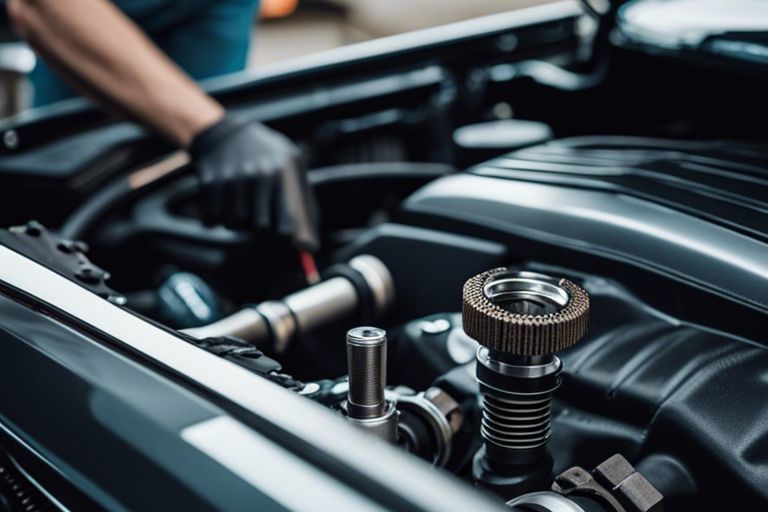Have you ever wondered how to effectively clean your exhaust valves without the hassle of removing the head? Well, we have good news for you. In this informative blog post, we will provide you with a step-by-step guide on how to clean your exhaust valves without the need for head removal. This method not only saves you time and effort, but it also helps prevent potential damage to your engine and ensures optimal performance of your vehicle. By following our expert tips and techniques, you can safely and effectively clean your exhaust valves without the need for costly and labor-intensive head removal.
Understanding Exhaust Valve Function and Build-up
The exhaust valves in your engine play a crucial role in the combustion process. As the name suggests, exhaust valves are responsible for allowing the burned fuel and air mixture to exit the combustion chamber. Over time, carbon and other deposits can build up on the exhaust valves, hindering their ability to function properly.
Role of Exhaust Valves in Engine Performance
The exhaust valves are essential for maintaining the proper flow of exhaust gases out of the cylinder. When the exhaust valves open at the correct time, they allow the burned fuel and air mixture to be expelled from the combustion chamber. This process is critical for ensuring optimal engine performance and preventing the build-up of harmful gases within the engine. If the exhaust valves are not functioning properly, it can lead to decreased power, reduced fuel efficiency, and potential damage to other engine components.
Common Causes of Carbon Build-up on Valves
One of the most common causes of carbon build-up on exhaust valves is the use of low-quality fuels. When you use dirty or low-octane fuel, it can leave behind more residue on the valves. Additionally, poor engine ventilation can also contribute to carbon build-up. If your engine is not getting enough air, it can create an environment where carbon deposits are more likely to form on the exhaust valves. Lastly, short, stop-and-go driving trips can also lead to carbon build-up, as the engine may not reach optimal operating temperature to burn off these deposits.
Preparing for the Cleaning Process
Assuming you’ve read up on the potential risks and benefits of cleaning your exhaust valves without removing the head, you’re ready to move on to the next step. If you’re still unsure about the process, you can find some helpful tips and advice on the topic by visiting this Reddit thread titled “Pulled the head. How to clean carbon off the valves safely?”.
Tools and Materials Needed
Before you start the cleaning process, you’ll need to gather a few essential tools and materials. You will require a set of socket wrenches, a gasket scraper, a can of carburetor cleaner, a wire brush, a small mirror, and a flashlight. These tools will help you gain access to the exhaust valves and effectively remove any built-up carbon deposits.
Safety Precautions and Preparatory Steps
When working on your exhaust valves, safety should be your top priority. Before you begin, make sure the engine is completely cool to avoid any burns or injuries. It’s also essential to disconnect the battery to prevent any accidental starts. Additionally, ensure the area is well-ventilated to avoid inhaling any harmful fumes or chemicals. Finally, to protect your eyes and skin, wear gloves and safety goggles throughout the cleaning process.

Step-by-Step Cleaning Guide
Now that you understand the basics of cleaning exhaust valves without removing the head, let’s dive into the step-by-step cleaning process. For more detailed information on this topic, you can also refer to this resource on Cleaning Carbon deposits from Valves?
| Chemical Cleaning Methods | Mechanical Cleaning Techniques |
|---|---|
| Effective for removing light carbon deposits without disassembling the engine | Utilizes specialized tools and equipment to physically remove hardened carbon buildup |
| May require multiple applications for stubborn deposits | Can be more time-consuming and labor-intensive compared to chemical methods |
| Less risk of damage to delicate components | Potential risk of damaging valves or cylinder head if not performed carefully |
Chemical Cleaning Methods
Chemical cleaning methods are a popular choice for removing light carbon deposits from exhaust valves without the need to fully disassemble the engine. You can use specialized cleaning solutions that are designed to break down and dissolve carbon buildup, making it easier to remove with minimal effort. These methods are effective for maintenance purposes and can help improve engine performance by restoring proper airflow through the valves.
Mechanical Cleaning Techniques
Mechanical cleaning techniques involve the use of specialized tools and equipment to physically remove hardened carbon buildup from exhaust valves. While these methods can be effective for more stubborn deposits, they require careful handling to avoid damaging the valves or cylinder head. It’s important to use the right tools and techniques to prevent any potential damage, but when performed correctly, mechanical cleaning can restore the valves to their optimal condition.

Post-Cleaning Maintenance and Tips
After cleaning your exhaust valves without removing the head, it’s crucial to follow up with some post-cleaning maintenance to ensure the longevity and efficient performance of your engine. Here are some important tips to keep in mind:
- Inspect your exhaust valves regularly to ensure they remain free of carbon buildup and deposits. This will help prevent any future issues and maintain optimal engine performance.
- Consider using a fuel system cleaner regularly to prevent carbon accumulation in the first place. This will help keep your exhaust valves and engine clean and functioning properly.
- Keep an eye on your engine’s overall performance. If you notice any decrease in power, rough idling, or excessive emissions, it could be a sign that your exhaust valves need attention.
Recognizing the signs early and taking appropriate action can save you from more extensive repairs down the line. For more information on cleaning an exhaust valve without tearing down the engine, you can visit this link.
Preventive Measures to Reduce Carbon Accumulation
To reduce the likelihood of carbon accumulation on your exhaust valves, it’s important to take some preventive measures. One effective way to do this is to use high-quality fuel and stay up to date with regular oil changes. Additionally, avoiding extended periods of idling and incorporating occasional high-speed driving can help burn off carbon deposits. By implementing these preventive measures, you can minimize the risk of carbon buildup on your exhaust valves and ensure a smoother operation of your engine.
Recommended Follow-Up and Performance Checks
Following the cleaning of your exhaust valves, it’s essential to carry out recommended follow-up and performance checks to ensure everything is in optimal condition. This includes monitoring your engine’s performance, checking for any unusual noises, and verifying that all components are functioning as they should. Additionally, consider having a professional mechanic perform a thorough inspection to address any underlying issues and prevent potential future problems. By staying proactive with these follow-up checks, you can maintain the overall performance and reliability of your engine over the long term.
Conclusion: How to Clean Exhaust Valves Without Removing Head
Summing up, cleaning your exhaust valves without removing the head is a fairly straightforward process that can greatly improve the performance of your engine. By using a valve cleaner and following the specific instructions for your vehicle, you can effectively remove carbon deposits and restore proper airflow without the need for extensive disassembly. Regular maintenance of your exhaust valves is essential to ensure that your engine continues to run smoothly and efficiently. By taking the time to clean your exhaust valves, you can extend the life of your engine and avoid costly repairs in the future. Remember to consult your vehicle’s manual for specific instructions and guidelines, and always take proper safety precautions when working on your engine.
FAQ
Q: What are exhaust valves and why do they need to be cleaned?
A: Exhaust valves are responsible for releasing exhaust gases from the combustion chamber. Over time, carbon deposits can build up on the exhaust valves, causing them to stick and reduce engine performance.
Q: Can exhaust valves be cleaned without removing the head?
A: Yes, it is possible to clean exhaust valves without removing the cylinder head using various methods such as chemical cleaners and walnut blasting.
Q: How can I clean exhaust valves with chemical cleaners?
A: To clean exhaust valves with chemical cleaners, you can use intake valve and combustion chamber cleaners specifically designed to break down carbon deposits. These cleaners are often sprayed into the intake system while the engine is running to reach the exhaust valves.
Q: What is walnut blasting and how does it clean exhaust valves?
A: Walnut blasting is a method of cleaning exhaust valves using crushed walnut shells as a blasting media. This process involves blasting the walnut shells at high pressure into the intake system, which then reaches the exhaust valves and effectively removes carbon deposits.
Q: Are there any precautions I should take when cleaning exhaust valves without removing the head?
A: When cleaning exhaust valves without removing the head, it is important to follow proper safety procedures and manufacturer guidelines for any cleaning products or equipment used. Additionally, taking precautions to prevent any debris from entering the engine is essential. It is recommended to consult a professional mechanic if you are unsure about the cleaning process.


